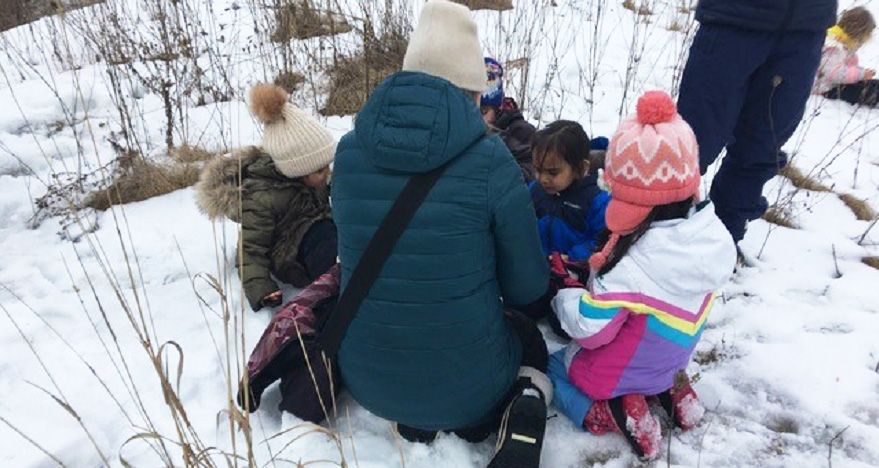Winter 2020
Posted by Fiona
Recently at The Nature Preschool, we have been noticing emotions.
Sometimes during drop-off, children become sad or feel anxious about their parent leaving and experience a surge of emotion. Sometimes they cry or shout or run after their parent.
For one child, sitting by the fire and talking quietly with a teacher helps them enter into the program for the morning. This child has said, “I like how quiet it is here.” Another child is helped by going for a short walk and seeing an activity that they find interesting.
The educators at The Nature School have been telling stories about emotions and labeling emotions for the children when we see them, to help the children learn about their feelings and the expression of them. We may point out, “You looked very happy when you jumped off that log because of the big smile on your face,” or “I see that you are angry and shouting right now because you want a turn with the binoculars. Waiting is hard.”

Self-regulation for preschoolers refers to children’s ability to regulate emotions, such as managing their frustration when a problem becomes too hard, calming down after some excitement, or waiting their turn for an object they really would like to have.
It also applies to the ability to focus on a task, or the ability to refocus on a new task. Transition times or temperature can be key stressors for some children, making self-regulation more difficult.
These are large tasks for preschoolers to learn, and it is normal for them to struggle along the way.
Being outside in nature promotes positive self-regulation skills for children. Stressors such as noise, lighting, and exposure to overstimulating images or colours are almost non-existent. There is natural light, natural smells, and natural noises. Children have more space, and the freedom to explore and play.
While at The Nature School, there are opportunities for the children to take the space they need to calm down, while still being supervised by the teachers. There are quiet places and private spaces where the children can feel secure and focus on feeling calm before returning to play.
Dr. Stuart Shanker has studied self-regulation in children in depth. He recommends three key steps to helping children self-regulate*:
(1) Reduce the overall stress level. This can be as simple as making the room quieter, ensuring they have time to rest, or making sure that the child has a nutritious snack. Many children have trouble with self-regulation if they are tired, hungry, or overwhelmed.
(2) Help your child become aware of what it feels like to be calm, happy, and alert. Many children are not self-aware enough to recognize this state and need the help of an adult to label it for them.
(3) The last step is to teach your child to return to that state of calm, happy and alert after experiencing an extreme emotion. This could be by taking deep breaths or squeezing a favourite toy.
*Reference: Shanker 2013; Ontario Ministry of Education [OMEd], 2014, p.25.
Here are a few things we can all do to help children practice regulating their emotions and feelings:
- Blowing bubbles is a great technique to use to help your child calm down. When they are upset, reminding them to take a deep breath and blow out, just like they are blowing bubbles helps them refocus and gain control of their emotions.
- Play hide-and-seek. Learning to stay quiet and hidden can be a challenge for some children, and playing this game supports this skill development.
- Playing freeze dance. Dancing can be quite exciting and enjoyable for children. Starting and stopping when they are not expecting to teaches them how to regulate their emotions when they are excited and need to stop suddenly.
